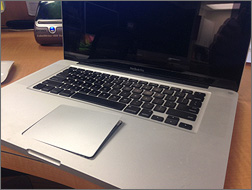One common problem with aging laptops is gradual loss of the ability to click the trackpad. It usually starts slowly as increasing pressure is needed to have the system register a button press. The problem then gets worse and worse, until the trackpad is unable to be depressed at all.
 This problem is usually caused by a failed battery. In Mac laptops the battery sits below the front half of the machine, under the palmrest and the trackpad. When Lithium ion batteries fail they are designed to swell and balloon to a larger size. This is a safety feature to contain explosion (generally a good thing), but can affect laptop operation.
This problem is usually caused by a failed battery. In Mac laptops the battery sits below the front half of the machine, under the palmrest and the trackpad. When Lithium ion batteries fail they are designed to swell and balloon to a larger size. This is a safety feature to contain explosion (generally a good thing), but can affect laptop operation.
If the battery fails the swelling exerts force on the top and bottom cases, reducing the small amount of space available to click the trackpad. Often the top or bottom of the laptop also gets pushed out a little (or a lot) for the same reason. Replacing the battery typically fixes the trackpad issues.
If you have an older MacBook, MacBook Air, PowerBook, iBook or non-Retina MacBook Pro the battery is easy to change. Retina MacBook Pros and the new MacBook have glued-in batteries (sigh) and require dealer servicing.

 Recent Posts
Recent Posts


